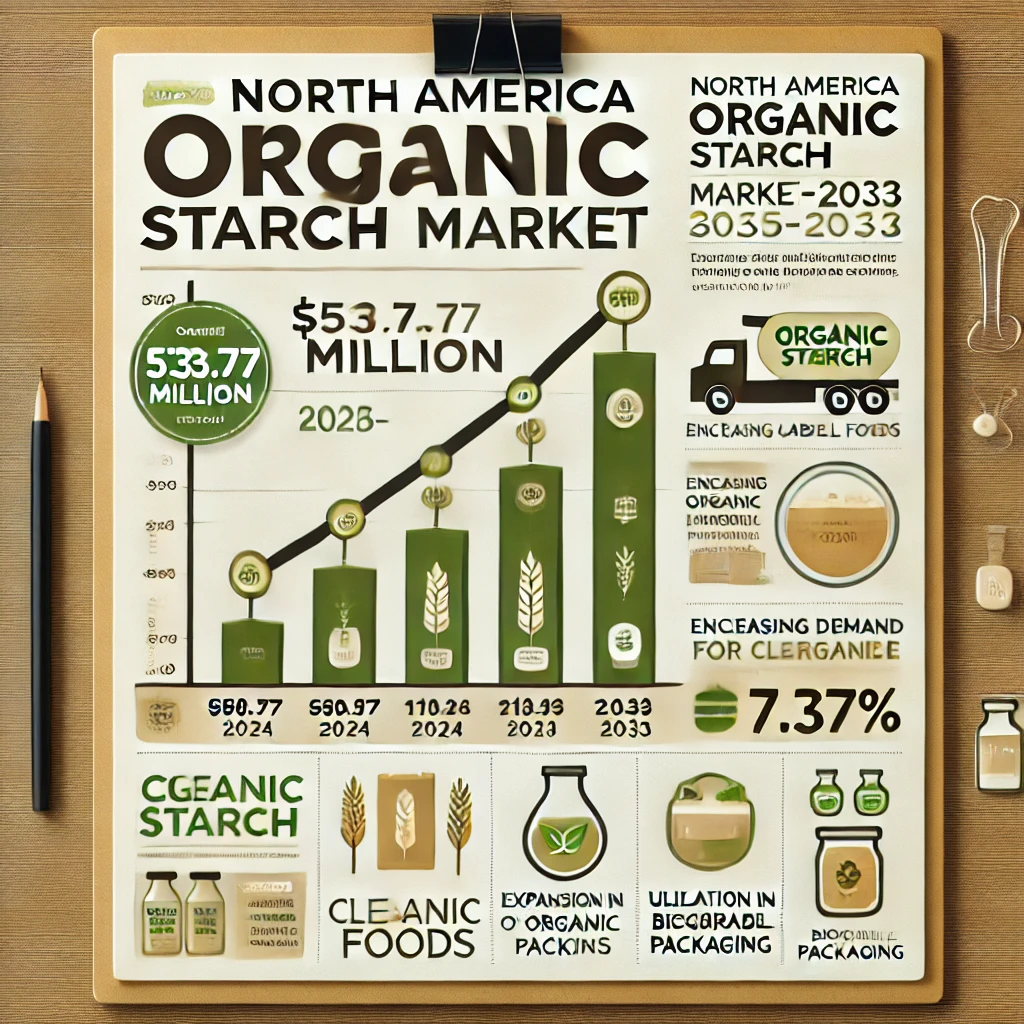North America Organic Starch Market Trends 2025-2033
North America Organic Starch Market: Comprehensive Analysis and Forecast (2025-2033) Market Overview The North America Organic Starch Market was valued...

North America Organic Starch Market: Comprehensive Analysis and Forecast (2025-2033)
Market Overview
The North America Organic Starch Market was valued at US$ 596.77 million in 2024 and is projected to grow at a CAGR of 7.37%, reaching US$ 1130.18 million by 2033. This growth is driven by the increasing demand for natural, organic, and clean-label food ingredients, coupled with the expanding applications in food, pharmaceuticals, and biodegradable packaging sectors. The trend of health-conscious consumer choices and sustainability-oriented purchasing decisions further propels market growth.
Download Sample: https://www.renub.com/request-sample-page.php?gturl=north-america-organic-starch-market-p.php
Market Dynamics
Growth Drivers
1. Rising Demand for Clean-Label and Organic Foods
- Consumers in North America are increasingly opting for food products free from artificial additives, GMOs, and synthetic chemicals.
- The shift toward organic and non-GMO certification has led to increased utilization of organic starch as a natural stabilizer and binder.
- Example: In October 2022, Roquette launched a new range of organic pea ingredients, including organic pea starch and organic pea protein, sourced from certified organic farms in Canada.
2. Expansion of Organic Farming and Sustainable Practices
- The USDA and Canadian organic certification programs are encouraging farmers to shift to sustainable agricultural methods.
- The transition towards organic farming enhances the supply chain for organic starch, ensuring a steady and quality-controlled product flow.
- Example: In May 2023, the USDA expanded financial assistance under its Organic Transition Initiative to support existing organic farmers and those transitioning to organic production.
3. Increasing Utilization in Non-Food Sectors
- Organic starch finds growing applications in pharmaceuticals, cosmetics, and biodegradable packaging.
- It is used as an excipient in pharmaceutical formulations and as an absorbent in cosmetic powders and skincare products.
- Example: In August 2024, Roquette Frères expanded its tapioca-based cook-up starches (CLEARAM series) for enhanced texture and viscosity in dairy desserts and bakery fillings.
Market Challenges
1. High Production Costs and Limited Supply
- Organic starch production requires rigorous certification, expensive farming practices, and lower crop yields.
- The cost-intensive nature of organic farming makes organic starch more expensive than conventional starch, affecting its competitive pricing.
2. Competition from Conventional and Modified Starches
- The affordability and functionality of conventional and chemically modified starches pose a challenge to organic starch adoption.
- Industries relying on chemically modified starch for stability and affordability may hesitate to switch to organic alternatives.
Market Segmentation
By Ingredient
- Organic Potato Starch
- Used in gluten-free baking, meat processing, and dairy alternatives.
- Acts as a natural thickener and stabilizer in soups, sauces, and baby food.
- Organic Wheat Starch
- Popular in bakery and confectionery due to its ability to enhance elasticity and texture.
- Also utilized in pharmaceuticals and cosmetics as a natural binder.
- Organic Corn Starch
- Extensively used in food processing and biodegradable packaging.
- A key ingredient in organic tortillas, sauces, and soups in Mexico.
- Other Organic Starches
- Includes tapioca, rice, and arrowroot starches, which cater to niche applications in organic food and cosmetics.
By End User
- Bakery Industry
- Organic starch improves moisture retention and shelf life in bread, cakes, and cookies.
- The rising demand for gluten-free and organic baked goods is driving growth.
- Meat Industry
- Used as a binder and moisture-retaining agent in plant-based and organic meat products.
- Enhances texture in sausages, burgers, and deli meats.
- Confectionery Industry
- Acts as a thickening agent in fillings and coatings for candies and chocolates.
- Ensures clean-label status for organic confectionery products.
- Dry Blends Industry
- Applied in seasoning mixes, baking powders, protein shakes, and meal replacement products.
- Increases mixability and stability in dry formulations.
By Country
- United States
- Largest market, driven by consumer preference for organic and USDA-certified food products.
- Strong presence of organic food brands and retailers.
- Expanding applications in biodegradable packaging and personal care.
- Canada
- Growing demand for organic baby food, functional beverages, and plant-based proteins.
- Government initiatives supporting sustainable agriculture.
- Increasing use of organic starch in biodegradable food packaging.
- Mexico
- High demand for organic corn starch in traditional cuisine.
- Expansion of organic farming programs and exports of organic food products.
- Growth in the natural cosmetics and personal care industry.
Competitive Landscape
The North America Organic Starch Market is highly competitive, with key players focusing on expanding their product portfolios and strengthening supply chains.
Major Companies Covered
- Cargill, Incorporated
- ADM
- Tate & Lyle
- Ingredion
- Roquette Frères
- BASF
- Naturex S.A.
- The Kraft Heinz Company
- Emsland Group
- American Key Food Products
Company Strategies
- Expansion of organic product lines and acquisitions.
- Strengthening raw material sourcing from organic-certified farms.
- Investment in sustainable and biodegradable applications of organic starch.
Conclusion
The North America Organic Starch Market is poised for significant growth due to increasing consumer demand for clean-label and organic food ingredients, expansion in non-food applications, and government support for organic farming. However, challenges such as high production costs and competition from conventional starches must be addressed through innovation and cost-effective production methods. With a growing emphasis on sustainability and natural product alternatives, organic starch will continue to play a crucial role in multiple industries across North America.



